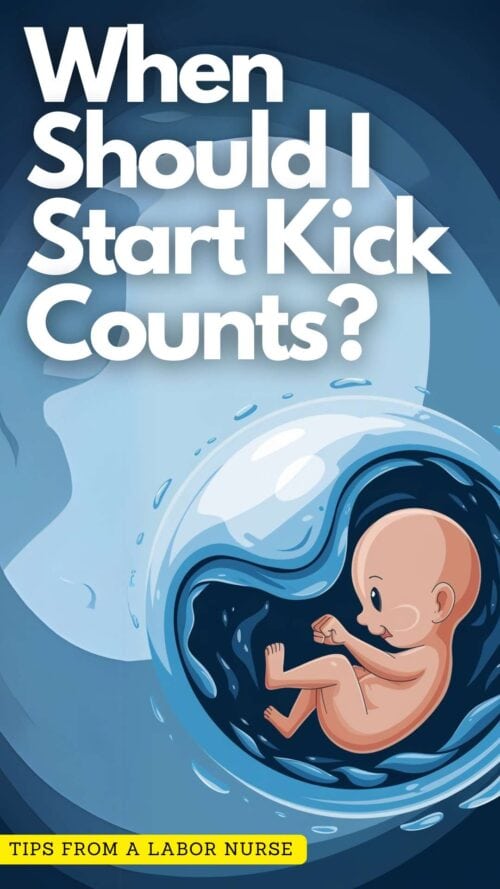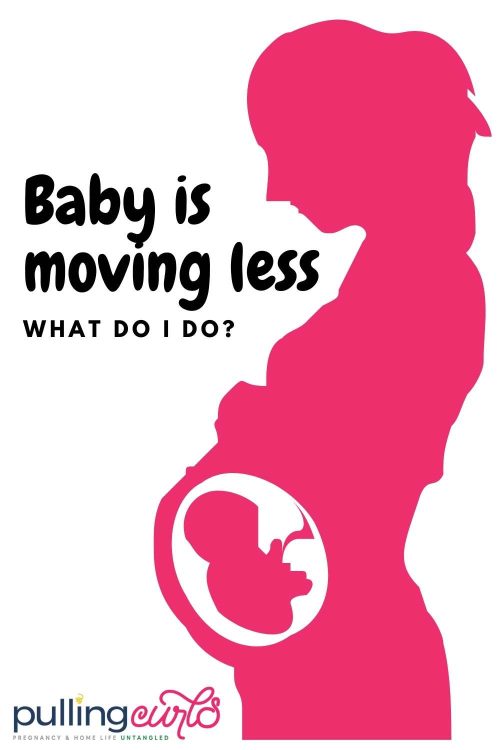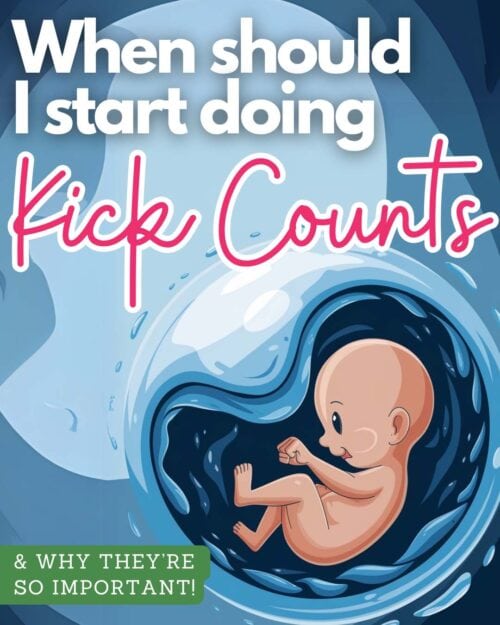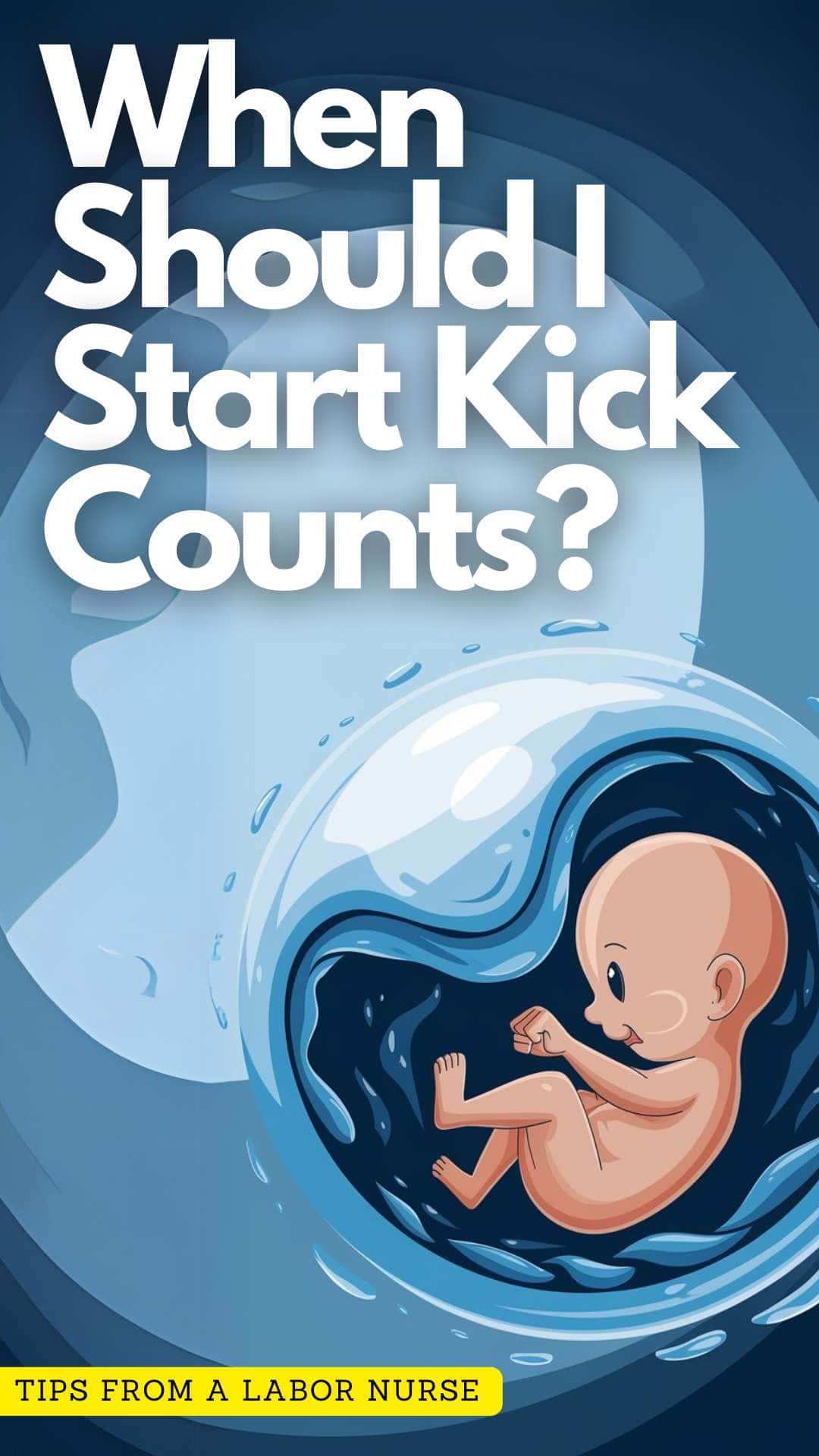Fetal movement is your best indicator of fetal well-being. I believe that with all my heart. So, when should you start kick counts? Or, maybe we should back-up and ask what kick counts are, why we do them, and what will the benefits be? Kick counts are very much a soapbox of mine — so I’m excited that you’re here!

Before we get going — I’m not just a believer in kick counts — I’m also The Pregnancy Nurse®. I’ve been a nurse since 1997 and I have 20 years of labor and delivery experience. The studies about kick counts really opened my eyes as to how important they are. I think they’ll help you see it too!
Oh, and I have a kick count cheat sheet that gives my best tips to making them work for you!
I also made a video of this post, in case you’re a watcher/listener and less of a reader:
When Should I Start Kick Counts?
The recommendation is around 27-28 weeks, as you’re heading into your third trimester. If you’re higher risk I’ve seen some providers recommend closer to 25 weeks or so.
This is also a GREAT time to get your birth class started. I recommend this one (so does BabyList).
Why start then?
Great question — I think it comes down to three things:
Baby Large Enough to Make an Impact — Baby needs to be at a good size where most people are feeling baby move. LOTS of people don’t feel baby until 20’ish weeks (or, don’t know that they’re feeling them). And, for those first few weeks it will be completely random… because there isn’t a…
Pattern of Fetal Movement — We need baby to be moving fairly frequently throughout the day. It’s also an extra win if you do your kick count at a time that baby tends to be active (we’ll talk more about that — so keep reading).
Viability — You may not really want to think about this one (and skip this if fetal loss is a big trigger for you) — but the reality is that if something is wrong we need to be able to help. If baby isn’t moving well, that means that baby may be compromised, and we can’t really do much to help a compromised fetus prior to about your 3rd trimester.
This all to say that if you’re having a lot of anxiety about the baby — and you’re around 25 weeks, and you’re feeling that pattern of fetal movement every day — I don’t think there’s anything wrong with starting them them. At the very least you’d become very familiar with your baby’s movement — which is always a win. Talk with your provider with any questions on how this works for YOU.
Looking for more info on pregnancy health — be sure to check out these posts:
- Splash! Everything To Know About Your Water Breaking
- 4 Things You Can Do to Prepare Your Cervix for Labor
- Weird Symptoms of Labor You Might Be Missing
- 35 Weeks Pregnant Checklist
- 7 Things You’re Doing Wrong in Your Third Trimester
Is it Just Kicks?
This is tricky — it’s really “fetal movement” — not just kicks. Kick counts just an easy way to talk about them, and most people talk about baby “kicking” when they move and are small. As your baby grows you’ll feel a lot more than just kicks. You’ll feel them shifting and rolling in the womb.
The only thing that doesn’t count is hiccups. These are rhythmic “bounces” that most people are able to identify. That type of movement doesn’t show the baby is making purposeful movements — so, if baby is having hiccups (which is very normal and fine) it’s smart to wait a little until they’ve stopped, unless you can easily tease out the hiccups from regular movements.
If you’re not sure what is movement vs a hiccup and you’re in your 3rd trimester (it starts to get more clear the further along you are) — this is a GREAT thing to ask about at your next prenatal appointment. I’m a huge fan of asking questions — it’s one of my 3 things to prepare for labor.
❤️🧡💛💚💙💜 I love, Love, LOVE that you’re here preparing — but I gotta ask if your partner is just as on board for how different things are going to be. If you’re thinking you’d like for you to BOTH get prepared I recommend this. Check it out!
What do the studies show?
The one that put this on my own radar was this study — where they pushed using the app, and really monitoring baby’s movement in the state of Iowa. They made it a goal to talk about a prenatal appointments and just an overall push to make people more aware — and stillbirth rates fell:
Iowa’s state’s stillbirth rate went down 32% while rates in the rest of the country remained relatively stagnant. — Read more about the evidence here.
Yeah, you read that — that’s 1/3 stillbirths can be prevented. You can read the full study here.
This study showed in Norway showed similar results — decreasing stillbirth by 30%
This Cochrane meta-analysis showed that those counting fetal movement were more likely to find baby wasn’t growing well (called IUGR) vs those who weren’t monitoring fetal movement.
That study also showed (because it included several studies) the variance in how people count baby’s movements. The ways every study monitored fetal movement was pretty different. It makes it hard to be very scientific about it.
This meta analysis showed there was a decrease in poor neonatal outcomes (think poor apgar scores, or NICU admission) without an increase in interventions.
Sources:
- Burgess A, Aucutt M, Coleman SL. Standardizing Fetal Movement Monitoring using Count the Kicks. MCN Am J Matern Child Nurs. 2024 Nov-Dec 01;49(6):306-313. doi: 10.1097/NMC.0000000000001048. Epub 2024 Oct 15. PMID: 38976790; PMCID: PMC11472900.
- Mangesi L, Hofmeyr GJ, Smith V, Smyth RM. Fetal movement counting for assessment of fetal wellbeing. Cochrane Database Syst Rev. 2015 Oct 15;2015(10):CD004909. doi: 10.1002/14651858.CD004909.pub3. PMID: 26467769; PMCID: PMC9270931.
- Effect of encouraging awareness of reduced fetal movement and subsequent clinical management on pregnancy outcome: a systematic review and meta-analysisHayes, Dexter J.L. et al.American Journal of Obstetrics & Gynecology MFM, Volume 5, Issue 3, 100821
- Tveit JV, Saastad E, Stray-Pedersen B, et al. Reduction of late stillbirth with the introduction of fetal movement information and guidelines – a clinical quality improvement. BMC Pregnancy and Childbirth. 2009 Jul;9:32. DOI: 10.1186/1471-2393-9-32. PMID: 19624847; PMCID: PMC2734741.
- TY – JOUR AU – Heazell, Alexander E. P. AU – Holland, Fiona AU – Wilkinson, Jack C8 – BJOG-22-1454.R1 TI – Information about fetal movements and stillbirth trends: Analysis of time series data JO – BJOG: An International Journal of Obstetrics & Gynaecology JA – BJOG: Int J Obstet Gy VL – 130 IS – 8 SN – 1470-0328 UR – https://doi.org/10.1111/1471-0528.17426
- Hui Huang, Olivia Ceavers, María C Pinzón-Iregui, Melissa M. Howard, Connecting with fetus: The use of app-based fetal movement ounting and experiences during pregnancy and birth, Midwifery, Volume 140, 2025, 104214, ISSN 0266-6138, https://doi.org/10.1016/j.midw.2024.104214.
❤️🧡💛💚💙💜 I love, Love, LOVE that you’re here preparing — but I gotta ask if your partner is just as on board for how different things are going to be. If you’re thinking you’d like for you to BOTH get prepared I recommend this. Check it out!
I did a podcast with Count the Kicks that you might find helpful too with more Kick Count FAQ’s
What do you do with this information?
You’re going to see a pattern of fetal movement as you do this activity. Baby should stay in that “zone of safety” (taking about the same time every day to get to those 10 movements) — but if you’re finding that baby’s movements have changed a lot day to day you need to either call your provider or go to the hospital.
One of the things people like most about that app is that it alerts you if baby’s movement is outside of the “norm” — and because they are a research-backed group they have a lot of data to show what’s safe vs unsafe for how baby’s movements vary (because it will NOT be the exact same amount of time each day).
Big changes in fetal movement should send you directly to labor and delivery (not wait for a call from your provider). I have a whole article on what to do if baby is moving less.

BIG TIP: Make sure that you’ve eaten and drank water before or during your kick counts. If you’re not giving baby the nutrients it needs, baby is less likely to move — so make sure that you’re feeding yourself!
What will your provider/hospital do?
I am not sure what doctors do (I guess they’d assess things over the phone and send you to L&D if something seems off) — but in the hospital we do an NST on your baby. We’ll see how they’re managing regular life in the womb.
Most often they’ll also order a BPP as well that checks for a variety of things on baby. I talked about the BPP and fetal testing on my podcast with a well-known ultrasound tech:
If you’re truly doing kick counts in your third trimester and you notice fetal movement is off — your provider/hospital should take this seriously. Most often beyond the NST (which we do for anyone in their third trimester at the hospital) they should order a BPP and maybe further if baby looks OK right then. If they aren’t, be very clear with your words that you do daily kick counts, your baby’s movement is much less (using as many “numbers” as you can) and you know that increases your risk for stillbirth and you want help! Hopefully that will help them take you more seriously.
My Doctor Told Me Not To Do Kick Counts.
As I sit here and silently scream, I’ve gotta tell you that’s a red flag 🚩🚩🚩 for me. Providers should be very happy for you to do kick counts properly, as it has been shown to reduce stillbirth rates, and decrease anxiety in pregnant moms.
In my experience, the providers that don’t encourage kick counts honestly just don’t want the calls that baby is moving less. Yes, that might save some babies — but it interrupts their lives.
There are going to be some false alarms with this system — but when you do it this way they’re less likely to happen, and should trigger action on your healthcare team.
Personally, I really think there are less false alarms because you’ve created a SYSTEM of monitoring, vs just “how’s baby moving”?
If they tell you not to do kick counts, I’d ask them why. I’d probe further, and honestly — it might be a reason to switch doctors. But, that’s me.
Yes, there are studies that show it doesn’t help, but they aren’t well-controlled and had a wide-variety of fetal movement monitoring methods — feel free to share the ones done like we’ve discussed like this one. Maybe you can help them realize they’re wrong.
There is a push working to really help providers all use standardized language to talk about kick counts, so we can stop the confusion. We’re just not there yet.
AND, if you’re in your third trimester (or close to it) — I think you’ll find this checklist pack so helpful:
What About Twins?
I have talked to MANY twin moms who say they can tell which twin is moving. If you’re pregnant with twins, I think this a great conversation to have with your provider.
❤️🧡💛💚💙💜 I love, Love, LOVE that you’re here preparing — but I gotta ask if your partner is just as on board for how different things are going to be. If you’re thinking you’d like for you to BOTH get prepared I recommend this. Check it out!
What Are Kick Counts?
While we’ve talked about kick counts for a long time in the US, we haven’t found a way to all talk about them the same way. I’ve found a lot of providers say 10 movements in 2 hours and that IS NOT kick counts. It is not evidence-based, and hasn’t been shown to help reduce stillbirths.
The way the data has shown us is most helpful is to do it this way:
- Sit or lay down (if possible — as a nurse this wasn’t always possible) and note the time.
- Note every time baby moves (and count it)
- Once you count 10 movements, note the time again — how many minutes has it been since you started.
- Do this daily at about the same time (if possible). Keep noting how long it takes for baby to move 10 times.
There’s lots of ways to do this, but most people love the Count the Kicks app. There’s other apps out there too — you might want to see if your favorite pregnancy app already has it.
The amount of time this takes really varies person to person. This is my time to beg you to not compare your baby’s kick counts to anyone else’s. You’re only comparing YOUR baby to YOUR baby with this system.

Looking for more evidence-based pregnancy info — be sure to check out these posts:
- Do Birth Classes Improve Birth Outcomes? What do the studies show?
- Can You Drink Wine When You’re Pregnant: The studies for pregnant women
- 4 Things You Can Do to Prepare Your Cervix for Labor
- 5 Things You Need to Know About Preeclampsia
- Safest Age Gap Between Kids: For Health of Mom & Baby
Why this is the right way to do kick counts?
Because it really puts a “number” to what you’re feeling about baby moving.
That isn’t to say that monitoring baby throughout the day isn’t awesome, but we’re busy people — it can be hard to know if you’ve just gotten busy and ignored it, or if baby is truly moving less?
I will say, as a nurse, sometimes the “I’m just worried about baby” made it hard to really assess what was wrong and help the mom. That, vs the mom coming in to say that baby usually had 10 movements in 10 minutes and today she was well over 30 before getting 10 and she’d just like baby checked.
It sort of helps us know it’s not just general anxiety, but that you’re really monitoring it and being aware.
Also, this compares YOUR baby to YOUR baby.
Things that effect feeling fetal movement:
- Baby’s size — as you can imagine it’s harder to feel a smaller baby’s movements vs a larger one (a big part of why we don’t start til’ 27 weeks)
- Placental placement — if your placenta is in the front (called an anterior placenta) those movements are more likely to be “blunted” by the placenta — these parents often feel baby much less — and it is VERY important that they compare their baby to their baby vs what someone else feels.
- Baby’s position — If baby’s limbs are close to important structures you’re more likely to feel them move vs if their limbs are not
- Mom’s body — If the patient is larger, or smaller that can also effect how they feel the baby move.
Wish you’d gotten that cheat sheet? I’ve got it right here for you:
What are the other benefits to kick counts?
One of the other things I think a lot of people find themselves enjoying is the bonding they get as they just sit and feel for baby to move.
Maybe they dream about that positive future they’re both going to have too. It’s just a very positive time with a lot of benefits.
I also gotta remind you that getting prepared for your birth is another way to make your pregnancy more positive (and have a better birth). I recommend doing this.
Have you checked a birth class off your to do list✅? I have a few I recommend:
❤️ Best class for couples {per BabyList}
👩💻 Best class available on demand
⚡ Best class JUST for pain management
👶 Best Postpartum-Only Prep
❤️🧡💛💚💙💜 My favorite class is here.
Now is the time to get started!
Anxiety About Counting Kicks?
I hear a lot of people saying that counting baby’s movements will give them anxiety. This study showed that when done right (and they recommended using the Count the Kicks App) it can actually reduce anxiety.
This study also showed decreased anxiety, and more bonding with the baby.
If you’re worried it will make you worry, I would recommend giving it a try — and trying to dream and stay positive about it. This is a time to dream… that first smile, the time they realize what a Christmas tree is, that Halloween costume you’ll dress them in when they’re 2. There is so much good coming up with this little one. Dream.
What about just “monitoring fetal movement”?
I often hear on social media that they just “monitor fetal movement” and that’s enough — and I have to say that type of monitoring is showed in studies like this — where it’s not as concrete or systematic — and that does not show the benefits of how long it takes to get 10 movements.
This isn’t to say that you completely ignore fetal movement the rest of the time you’re not doing kick counts — you’re still going to keep an eye on it. That’s smart!
How to make kick counts work for you?
I get this, as a mom to many kids, and a busy nurse I sort of brushed kick counts to the side telling myself I was great at monitoring movements.
However, my doctor handed me a laminated card where I was to track my kick counts, which made me think it was more important.
Personally, I couldn’t do it the same time every day. On days I didn’t work I did it after dinner. That was a time that baby moved a lot, and I also got out of cleaning-up dinner.
When I worked, however, I’d try to do them as I sat charting sometime around dinner time — but it varied a lot. I just tried to do the best I could — if you do your best, that’s all you can do.
I have heard nothing about positive things about the Count the Kicks App — I’d encourage you to download it and see if you like it too.
Learning to make things work for you and your pregnancy is one of the smartest things you can do.
Come join me in The Online Prenatal Class for Couples where we give you evidence-based, non-biased tips for managing your pregnancy, labor, birth and life after baby.
Plus, it only takes a few hours, and you can do it from your couch (much like kick counts). I know you’ll love it (in fact we guarantee it).
Have you checked a birth class off your to do list✅? I have a few I recommend:
❤️ Best class for couples {per BabyList}
👩💻 Best class available on demand
⚡ Best class JUST for pain management
👶 Best Postpartum-Only Prep
❤️🧡💛💚💙💜 My favorite class is here.
Now is the time to get started!
So, are you doing kick counts? How are you making it work for you? Tell us in the comments!









Leave a Reply